Pottery Tips and Techniques for Beginners
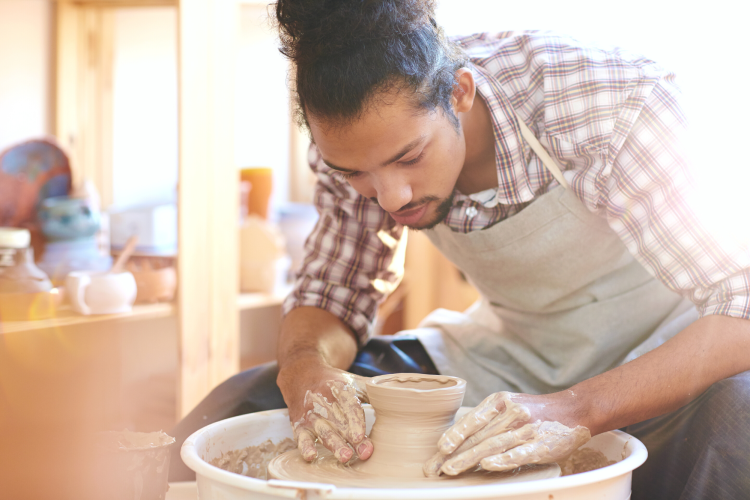
Do you have a budding interest in learning pottery for beginners but aren't sure where to start? This quick guide will lead the way as you begin your journey toward becoming a master potter. A Berkeley University interview shares the many reasons why artists make art, with responses ranging from its benefits of self expression to stress relief, entertainment and more. No matter your reason for seeking out a new creative hobby, you’ll gain a new perspective with our tips for getting started with pottery, a few pottery making techniques and plenty of pottery ideas for beginners. Let’s get started!
Jump to Section
- How to Get Started With Pottery
- Pottery for Beginners Techniques
- Pottery for Beginners Tips
- How to Glaze Pottery for Beginners
- Pottery Ideas for Beginners
How to Get Started With Pottery
Take a Pottery Class
One of the easiest ways to get started with pottery for beginners is to enroll in fun, hands-on pottery classes. For those in California, there are classes across the state, from pottery classes in San Francisco to pottery classes in San Diego. Or, you can search for pottery classes near you to find classes in your area! Pottery classes can be helpful for all levels of potters, from beginners to those with more experience.
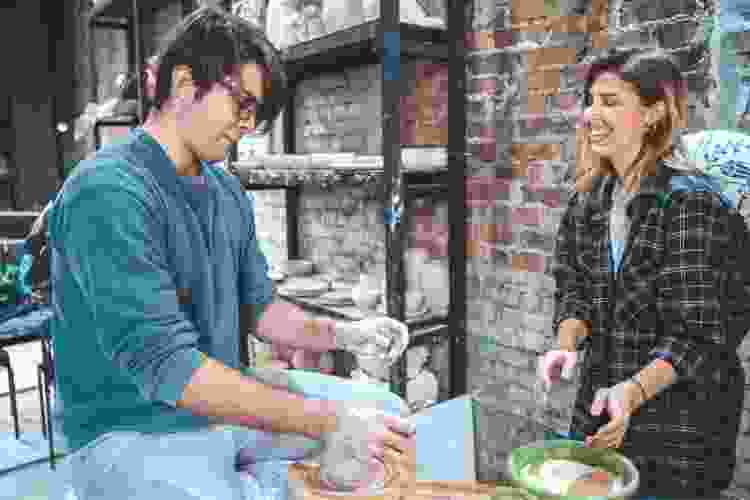
What to Expect in a Pottery for Beginners Class
In a pottery for beginners class, you will learn techniques for pottery for beginners from experienced potters. The potters will show you techniques for shaping the clay, using a throwing wheel and using special tools to shape your creations. You’ll get to create a few pieces in class and take them home with you a few weeks later after they are fired and ready. If you would like to continue to practice your skills and grow as a potter, consider enrolling in weekly pottery classes for beginners.
Start With Hand Building Pottery
Hand building pottery is built by hand without a potter’s wheel, and is a perfect stepping stone for those just starting to practice pottery for beginners. All it takes to begin hand-building pottery is a block of clay and your own two hands! With these two materials, you can begin shaping pots and vessels of many types. Beginning your pottery journey with hand building is the best way to start practicing pottery for beginners without investing in an expensive potter’s wheel.
You will, however, need access to a kiln to fire your clay pieces. Research pottery studios in your area to see if there are kilns available for you to use for a small fee. Or learn to make your very own with our DIY potter's kiln article.
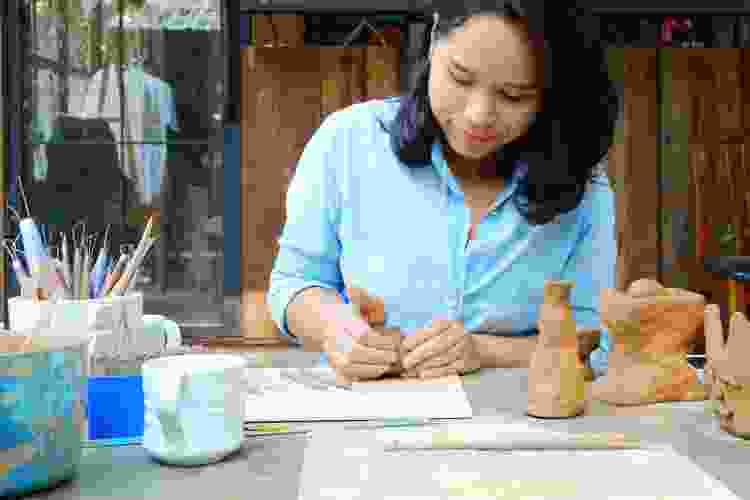
Pottery for Beginners Techniques
Hand Building Pottery Techniques
If you begin with hand building your pottery, there are a few techniques that would be helpful to know as you begin.
The first is “pinching,” where you roll the clay into a ball, make an indent in the middle with your thumb, then pinch the sides of the ball with your thumb in the middle to form a pot.
Another pottery for beginners technique is “coiling.” For this method, you begin with a slab of clay to form the base of your vessel. Then, you roll another piece of clay into a long, skinny cylinder which you then coil on top of the base to create your vessel.
“Slab building” pottery uses slabs of clay to construct the piece.
Carving pottery is another hand-building technique. This technique requires a few tools like a knife and spoon to carve the vessel. You begin with a solid block of clay and carve and scoop the clay away until you’ve created the vessel. And don't forget to create a unique signature like some of the most valuable pottery marks.
Throwing on the Potter’s Wheel
When you picture making pottery, you probably imagine making it on a spinning potter’s wheel. This way of making pottery takes practice and the purchase of (or access to) a potter’s wheel. If you’re just beginning your pottery for beginners journey, you may want to enroll in a few pottery classes to try your hand at using a potter’s wheel before investing in your own wheel at home.
Making pottery on a wheel is called “throwing.” A wet ball of clay is held in the center of the wheel while it spins. After making an indentation in the top of the clay, you use your hands and fingers to move the clay upward as it spins and shape the sides of the vessel.
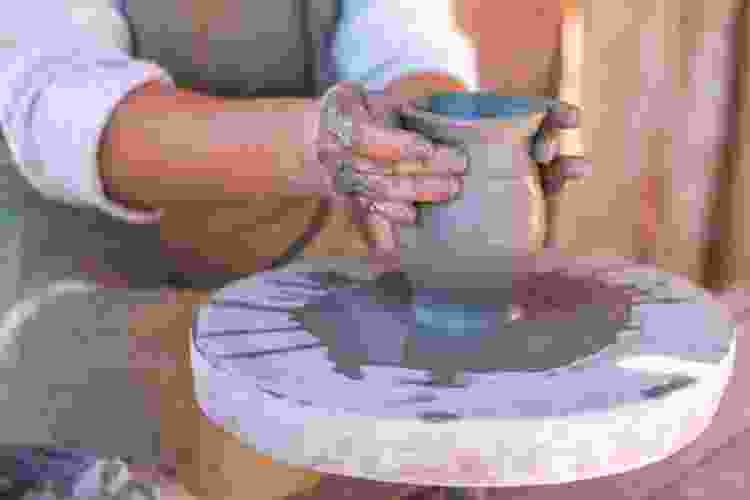
Slip Casting
Slip casting is another pottery for beginners technique that does not require a potter’s wheel. “Slip” is clay that has been mixed with water until it is either pasty or runny. This slip can then be poured into a plaster mold. Once dry, it’s easy to remove from the mold. Slip casting is advantageous for creating multiple copies of a piece of work.
Pottery for Beginners Tips
Tools for Pottery for Beginners
When you’re just beginning your foray into pottery, you don’t need very many tools. Experienced potters recommend starting with just a few key tools and adding more to your collection as you need them. Here are a few tools that will help you get started as you begin your pottery journey:
- Cut off wire: a cut off wire helps remove the piece from the potters wheel
- Sponge: a small sponge is used to keep the clay wet as you work
- Sponge on stick: a sponge on the end of a stick will help remove excess water from inside the pot
- Chamois: a small strip of chamois (cut down a larger chamois from an auto store!) is perfect for smoothing the rims of pots
- Wooden rib: a wooden rib is helpful for smoothing the base of dishes or bowls
- Pin tool: a pin tool is useful for popping air bubbles in the clay or as a cutting tool
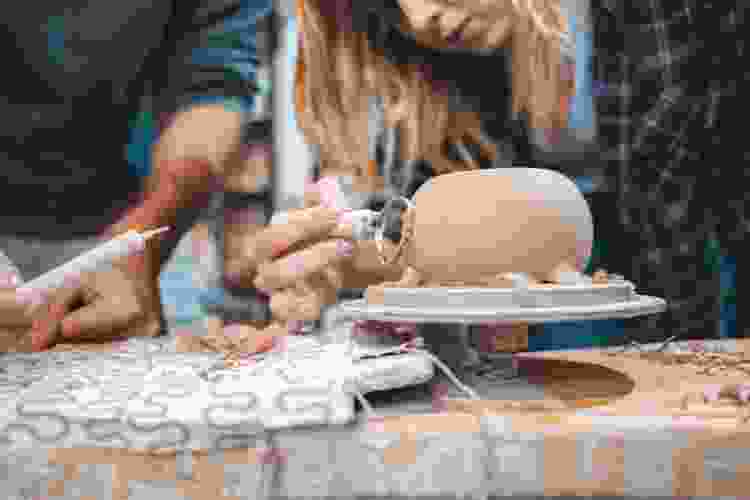
Joining Pieces of Clay
When building slab pottery, adding handles to a pot or mug, or adding any clay decoration to a vessel, you’ll need to join the clay properly to ensure the attachment sticks. This can be tricky when starting pottery for beginners. To join, score both pieces of clay where they will meet and apply a little slurry or water. Then firmly press the two pieces of clay together. Smear a bit of clay over the joint for extra reinforcement.
Storing Works in Progress
It is important to remember when starting pottery for beginners that unfired works in progress must be carefully stored to keep the clay from drying out. When you finish for the day, spray your clay with some water and wrap it tightly until your next work session. All unused clay can be recycled and reused — just throw it in a bucket with some water. When you’re ready to use it again, dry out the slurry on a board and knead until it reaches your desired consistency.
How to Glaze Pottery for Beginners
Once your piece is complete, it must dry before it can be fired in the kiln. Before firing, the pottery is very delicate, so treat it with extreme care.
Pottery is usually fired in the kiln twice. The first fire is called the bisque fire, which hardens the pottery. If making something like a flower pot, you may stop here. But if you would like to apply glazing, this is the time to do it. Once the glaze is applied, it’s time for the second firing: the glaze fire.
There are different ways to apply glazing to your pottery. The main methods of how to glaze pottery are dipping, spraying, pouring and painting. Each method produces different effects once fired. Read on for examples of these methods and more pottery for beginners ideas.
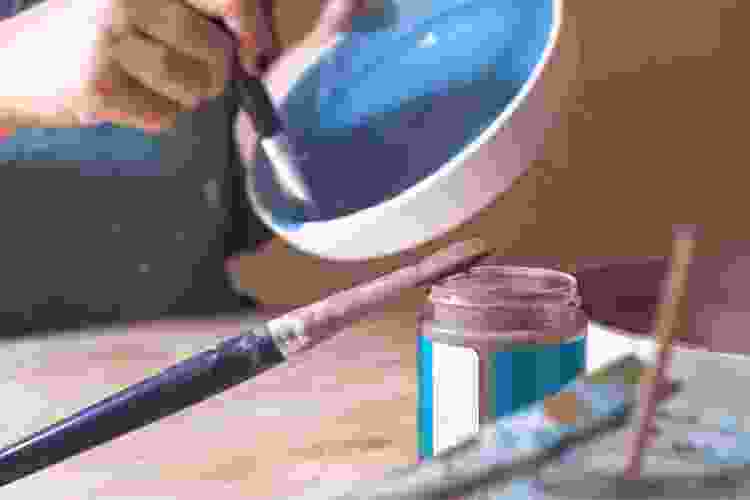
Pottery Ideas for Beginners
Spray Glaze
Spray glazes are — you guess it — sprayed onto the pottery. You’ll need a spray gun, a well-ventilated area and some finess to use this glazing method.
Pour Glaze
For this method of glazing pottery for beginners, you pour the glaze onto your piece of pottery. Start with the inside of the pottery then glaze the outside. This method avoids touching the outside once glazed.
Brushed Glaze
A brushed glaze is applied with a paintbrush. Use a generous amount of glaze to avoid streaks and to achieve a rich color.
Pottery Mug
A pottery mug is a great piece of pottery for beginners. It’s simple and functional, yet there are thousands of ways to make your mug unique. Shape the mug into a flower or animal, apply colorful glaze or play with the shape of the handle…the options are almost endless!
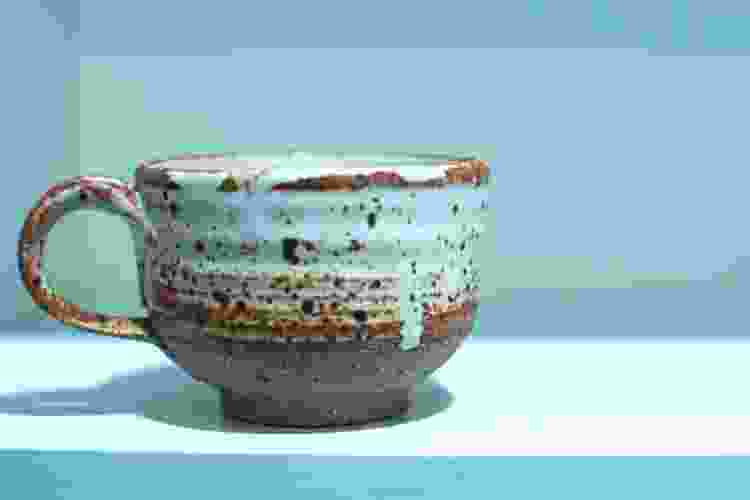
Pottery Plates
Can you imagine serving dinner to your guests on hand-thrown pottery plates? This pottery idea for beginners is perfect for practicing your skills for recreating a similar dish.
Pottery Ring Dish
Pottery ring dishes are a great pottery idea for beginners because they are small and simple. You can sculpt a dish using slabs of clay or the pinching method, or use the potter’s wheel for a smooth little dish.
Pottery Candle Holder
Craft a pottery candle holder on the potter’s wheel or by hand. This pottery for beginners idea leaves much room for creativity whether your tastes are elegant, chunky or sculptural.
Pottery Ornaments
Hand-craft pottery ornaments for all your loved ones to display during the holidays! You could make ornaments that commemorate special moments in your loved ones’ lives or stick to classic holiday motifs like stars, gingerbread men or nutcrackers.
Pottery Vases
Creating a stunning vase out of clay is a great way to start pottery for beginners and to display something beautiful in your home or to give as a gift. Leave it unfired to create a rustic flower pot, or finish it off in the kiln with a brushed glaze for a glossy finish.
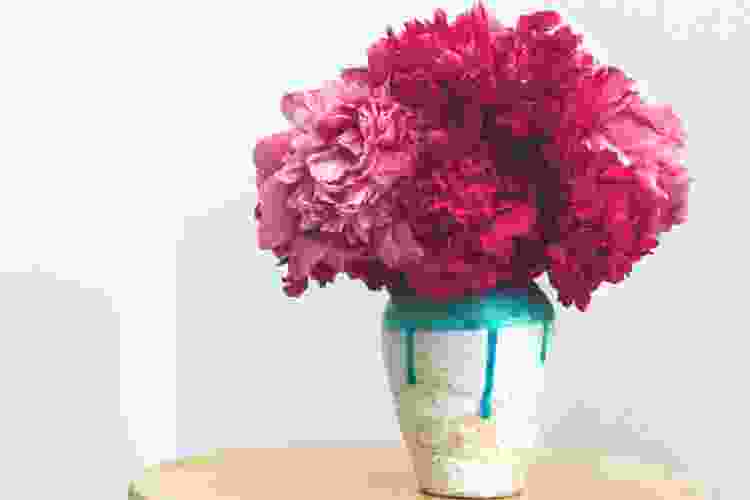
There’s so much to learn and discover as you begin your pottery journey. We hope these tips and techniques for pottery for beginners have inspired you to get your hands dirty on the potter’s wheel.
For even more creative ideas and inspiration, check out other experiences happening on Classpop!

